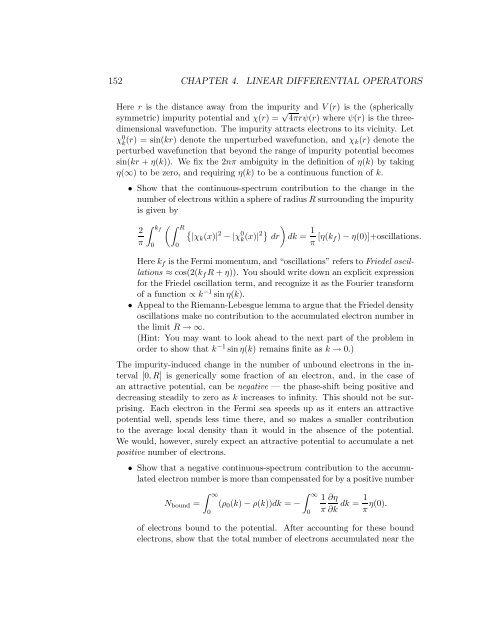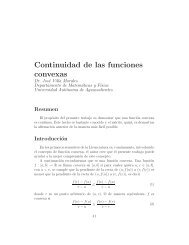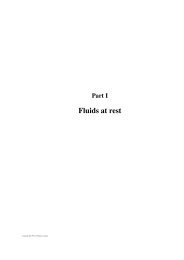Chapter 4 Linear Differential Operators
Chapter 4 Linear Differential Operators
Chapter 4 Linear Differential Operators
Create successful ePaper yourself
Turn your PDF publications into a flip-book with our unique Google optimized e-Paper software.
152 CHAPTER 4. LINEAR DIFFERENTIAL OPERATORS<br />
Here r is the distance away from the impurity and V (r) is the (spherically<br />
symmetric) impurity potential and χ(r) = √ 4πrψ(r) where ψ(r) is the threedimensional<br />
wavefunction. The impurity attracts electrons to its vicinity. Let<br />
χ 0 k (r) = sin(kr) denote the unperturbed wavefunction, and χk(r) denote the<br />
perturbed wavefunction that beyond the range of impurity potential becomes<br />
sin(kr + η(k)). We fix the 2nπ ambiguity in the definition of η(k) by taking<br />
η(∞) to be zero, and requiring η(k) to be a continuous function of k.<br />
• Show that the continuous-spectrum contribution to the change in the<br />
number of electrons within a sphere of radius R surrounding the impurity<br />
is given by<br />
kf 2<br />
π 0<br />
R<br />
0<br />
<br />
|χk(x)| 2 − |χ 0 k (x)|2 <br />
dr dk = 1<br />
π [η(kf ) − η(0)]+oscillations.<br />
Here kf is the Fermi momentum, and “oscillations” refers to Friedel oscillations<br />
≈ cos(2(kf R + η)). You should write down an explicit expression<br />
for the Friedel oscillation term, and recognize it as the Fourier transform<br />
of a function ∝ k −1 sin η(k).<br />
• Appeal to the Riemann-Lebesgue lemma to argue that the Friedel density<br />
oscillations make no contribution to the accumulated electron number in<br />
the limit R → ∞.<br />
(Hint: You may want to look ahead to the next part of the problem in<br />
order to show that k −1 sin η(k) remains finite as k → 0.)<br />
The impurity-induced change in the number of unbound electrons in the interval<br />
[0, R] is generically some fraction of an electron, and, in the case of<br />
an attractive potential, can be negative — the phase-shift being positive and<br />
decreasing steadily to zero as k increases to infinity. This should not be surprising.<br />
Each electron in the Fermi sea speeds up as it enters an attractive<br />
potential well, spends less time there, and so makes a smaller contribution<br />
to the average local density than it would in the absence of the potential.<br />
We would, however, surely expect an attractive potential to accumulate a net<br />
positive number of electrons.<br />
• Show that a negative continuous-spectrum contribution to the accumulated<br />
electron number is more than compensated for by a positive number<br />
Nbound =<br />
∞<br />
0<br />
(ρ0(k) − ρ(k))dk = −<br />
∞<br />
0<br />
1 ∂η 1<br />
dk =<br />
π ∂k π η(0).<br />
of electrons bound to the potential. After accounting for these bound<br />
electrons, show that the total number of electrons accumulated near the




